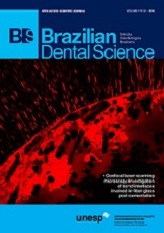Influence of sandblasting distance on enamel and ceramic structure bond strength
DOI:
https://doi.org/10.14295/bds.2014.v17i2.992Resumo
Objetive: The purpose of this study is was to evaluate the influence of sandblasting ceramic and enamel structure on bond strength, changing distance.
Material and methods: 60 third molars , were selected, enamel surfaces were ground flat with wet 600 - 2000 grit aluminum oxide abrasive papers and polished with three, one, and one-fourth micrometer-grit diamond pastes. Obtained 120 lithium disilicate-based core ceramic discs ( 2 mm diameter;1 mm thickness), divided into 7 groups [Group C, don’t sandblasting, Group SB-E(5-10) enamel sandblasting 5 and 10 mm, Group SB-C(5-10) ceramic sandblasting 5 mm and 10 mm, Group SB-EC(5-10) enamel and ceramic sandblasting 5 mm and 10 mm] after was performed microshear and Atomic Force Microscopy (AFM), Statistic Teste of normality , after one-way ANOVA and Tukey test (?: 0.05).
Results: The group C present bond strength (59.2±12.5), the group SB-E 5 mm (21.7±08.8) (p<0.005), the group SB-E10 (53.6±14.3).
Conclusion: The use of sandblasting treatment of the enamel surface a 5 mm by 20 seconds decreases the bonding strength to microshear.
Downloads
Downloads
Arquivos adicionais
Publicado
Como Citar
Edição
Seção
Licença
TRANSFERÊNCIA DE DIREITOS AUTORAIS E DECLARAÇÃO DE RESPONSABILIDADE
Toda a propriedade de direitos autorais do artigo "____________________________________________________________________" é transferido do autor(es) para a CIÊNCIA ODONTOLÓGICA BRASILEIRA, no caso do trabalho ser publicado. O artigo não foi publicado em outro lugar e não foi submetido simultaneamente para publicação em outra revista.
Vimos por meio deste, atestar que trabalho é original e não apresenta dados manipulados, fraude ou plágio. Fizemos contribuição científica significativa para o estudo e estamos cientes dos dados apresentados e de acordo com a versão final do artigo. Assumimos total responsabilidade pelos aspectos éticos do estudo.
Este texto deve ser impresso e assinado por todos os autores. A versão digitalizada deverá ser apresentada como arquivo suplementar durante o processo de submissão.




























